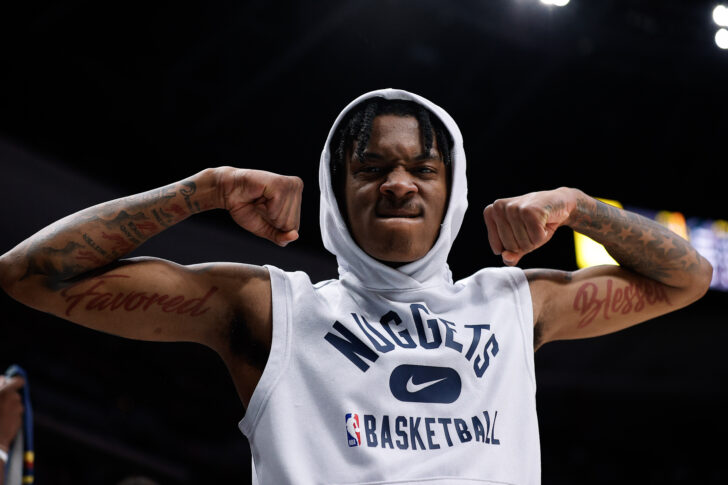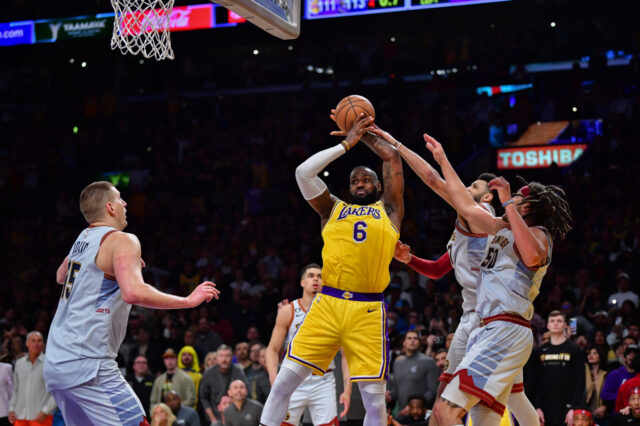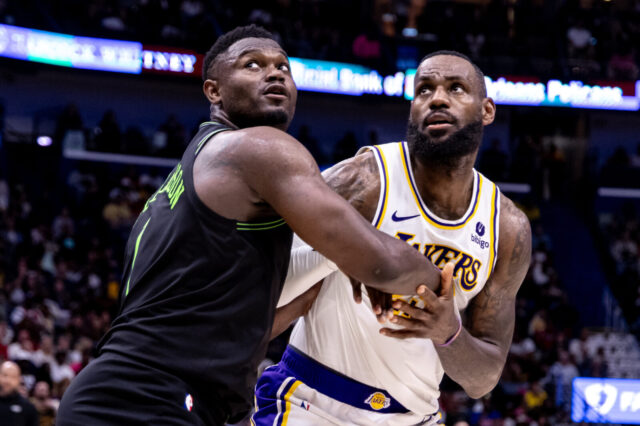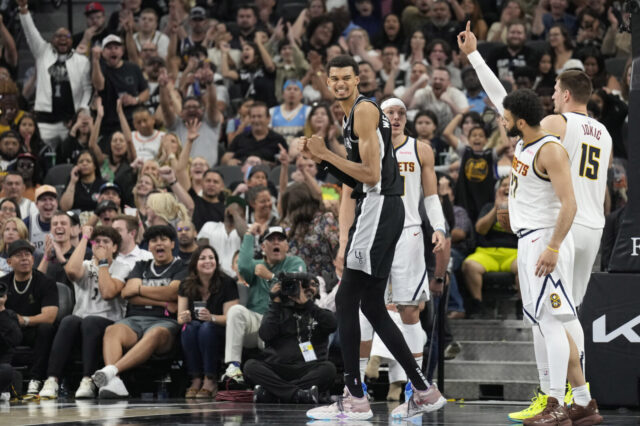The biggest joy of the 2021-22 Denver Nuggets season was watching Nikola Jokić wreck people on the way to a second straight MVP.
The second biggest joy was watching Bones Hyland.
Drafted with the 26th overall pick in the 2021 NBA Draft, Hyland had a special rookie season. Very few rookies score at the level Bones did while also being part of a winning team. Usually, players take time to find their rhythm and their teams sustain losses. While Bones himself started slow, he was able to contribute to a solid playoff team while maintaining the second highest usage rate.
To put into perspective how rare that is, the last rookie to exceed 1,000 minutes and a 23% usage rate on a greater than .500 team was Kendrick Nunn for the Miami Heat in 2019-20. Nunn was in his Age 24 season after a four-year college tenure plus a gap year. The last player to do it before Nunn: Donovan Mitchell in the 2017-18 season as the first option for the Utah jazz. Before that: Rodney Stuckey for the Detroit Pistons back in 2007-08.
Usually, teams go through growing pains in these situations, but Bones was in a unique position as Denver’s sixth man. He ran the offense when Jokić rested, utilizing pick and rolls, off-ball screens, and isolations to create for himself and others. The Nuggets played so well with Jokić on the court last year that they didn’t need the second unit to be incredible. Just good enough. As a result, Bones got a ton of reps as the first option, and things mostly went well during the second half of the season.
The Nuggets needed both Bones the initiator and Bones the energizer last year. He began the year as mostly a spark plug scorer at shooting guard. His primary role was to space the floor, but the Nuggets continued to find ways for him to create offense on the ball too. He was good at it, and the Nuggets were more successful when he ran the offense. As a result, the Nuggets removed Facu Campazzo from the backup point guard spot after a January 28th win against the New Orleans Pelicans. Bones replaced him, and Denver’s bench improved as a result.
The numbers also speak for themselves.
Bones began running a lot more pick and rolls with both Nikola Jokić and DeMarcus Cousins, showcasing growth as both a scorer and facilitator. His patience in the pick and roll was a bit of an afterthought due to his sublime outside shooting, but he won Denver some games with the ball in his hands.
Bones’ chemistry with Cousins in particular was notable. Though Cousins was more of a pick and pop big, he set hard screens to help generate separation for Bones. Once the rookie guard got a step on his defender, he often put that player in jail on his back and found his way to the middle of the paint. The Bones-Boogie pick and rolls became the foundation of Denver’s bench offense over the latter half of the season.
Even though he was handling the ball, Bones’ improvement as a shooter throughout the season was also extremely encouraging. Often, an increase in role and responsibility will result in a decrease in shooting efficiency. For Bones, that was anything but the truth. He improved as the year went along to the point that defenses treated him as a threat to shoot any time he stepped inside mid-court.
And for good reason.
After his switch to backup point guard, Bones had seven games with at least four three-pointers made. Even while he was facilitating, he was always hunting for the outside shot and liable to make them out to 30+ feet. It was one of his defining traits during his time at VCU, and it’s safe to say the deep threes will continue during his second season with the Nuggets.
The Nuggets felt so confident with Bones that they finally let go of longtime backup point guard Monte Morris, who filled in as a starter for Jamal Murray last year. With Murray expected back in his starting role and Bones showing himself capable, Morris was traded to the Washington Wizards along with Will Barton. The Nuggets brought back Kentavious Caldwell-Pope, expected to fill in at starting shooting guard, and Ish Smith, expected to back up Bones.
There’s always a chance that the Nuggets decide to play Bones at shooting guard a bit more next to Ish Smith, but it likely won’t be Denver’s primary bench unit. Instead, the Nuggets will be counting on Bones to at least replicate what he did as the point guard last season, if not take a full-fledged leap.
While Denver won’t be leaving Bones to completely fend for himself, there’s a possibility that Bones will carry an incredibly high usage with the bench next year. In lineups featuring Bones, newcomer Bruce Brown, and holdovers Davon Reed, Jeff Green, and Zeke Nnaji, Bones is quite clearly the top dog offensively. He will be running plenty of pick and roll with both Green and Nnaji, as well as some wrinkles with Brown as the screener.
In a perfect world, the distribution for shots within an offense involves each of the five players taking 20% of the possessions. Bones utilized 23.1% of possessions during his rookie season, according to NBA.com, and that number could skyrocket in lineups featuring the above bench unit.
The Nuggets could help Bones out by staggering their starters a bit. All three of Jokić, Murray, and Michael Porter Jr. could see some time assisting Bones with offensive creation in Denver’s bench units, and that should make the Nuggets better as a whole. All three bring different skill sets, all of which could benefit Bones greatly.
But the bulk of the responsibility will still fall in Bones’ shoulders to be the engine in those situations. The Nuggets will look to him to take that leap. While he’s certainly capable, it’s a dangerous game to plan for a rookie to be even better in their second season. Denver’s using that belief as a pillar of their bench identity. The idea is not without merit though.
Here are the rookie guards in the last 25+ years with the most similar scoring and playmaking profiles to Bones, using various qualifiers on the Basketball Reference database:
The minutes qualifier is certainly an important one. Damian Lillard produced his numbers as the first or second option in heavy minutes for the Portland Trail Blazers. All of the players in the above graphic played more minutes than Bones. There are simply very few guards with Bones’ level of shooting aggressiveness and efficiency that can also create for others at a reasonable level.
Another number that stands out: the three-pointers attempted. Bones’ 10.1 three-point attempts per 75 possessions is quite literally the most in NBA history for a rookie with 1,000+ minutes.
Bones Hyland was built to flourish in the modern NBA. His confidence and willingness to take ambitious shots has turned him into an elite floor spacer after just one season. Opponents know he will shoot from anywhere now, and that fear has created some opportunities for him and his teammates that certainly feels sustainable.
Some similar players to Bones, Tyler Herro, Tyrese Maxey, and Jordan Poole, all experienced breakouts this last season. Herro was primarily a sixth man while Maxey and Poole both spend the majority of their time as starters. All three are score first guards and around the same size, scoring in a variety of ways at young ages for successful teams. There’s no reason why Bones can’t become similarly impactful to those players. If he even approaches that level, the Nuggets will be extremely happy with his progress.
It’s up to Bones and the Nuggets to build upon that established rookie year. He will have to improve as a defender, and he still needs to play with some functional strength in the paint without getting bumped off his spot while dribbling in traffic. Those are correctable concerns though, and while one of the best teachers in these situations is time, another is experience. Bones got plenty of it as a rookie.
Now, Bones Hyland will have to be even better in his second season.





